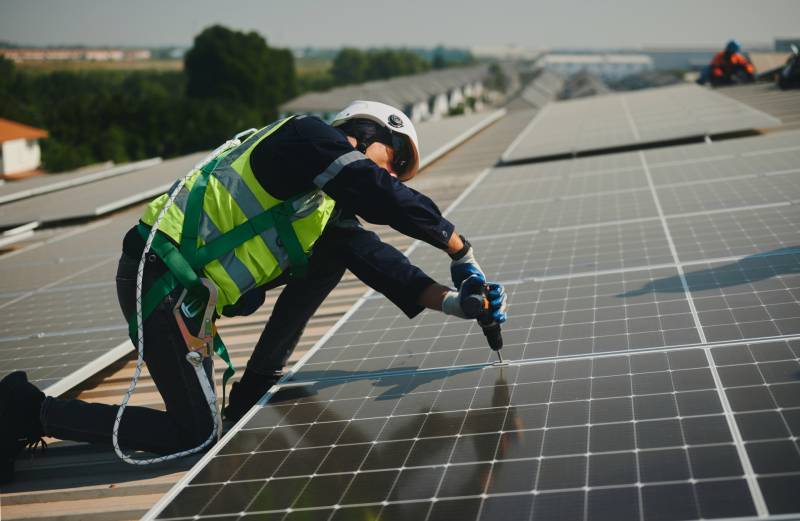LinkedIn is also tracking “green skills” that are increasingly being listed for industries not traditionally thought of as related to the climate at all, like sustainable sourcing and waste reduction in fashion.
This new economy will need to be powered by people. People with skills that, today, they largely don’t have, ready for opportunities they may not know about yet, don’t know how to train for or don’t see themselves in.
“The hard truth is that right now we are nowhere close to having sufficient green talent, green skills or green jobs to deliver the green transition,” the LinkedIn report states. “Based on the current trajectory of green skills growth in the labour market, we are not going to have sufficient human capital to meet our climate targets.”
I spoke to education and workforce leaders about what we need to do to fill the gap. Here’s what they said.
1. Invest in green job pathways
Although huge amounts of public and private investment are thundering toward these greener pastures, education and workforce experts say very little of it is dedicated toward building up the human capital that will be needed to do the work. Union apprenticeship programs often have waiting lists, high school career and technical programs have been neglected for decades in favor of the college track, and many community colleges are facing budget cuts.
“If we could expand our programs by 80 percent tomorrow, we would fill every single one of our seats,” said Pedro Rivera, the president of Thaddeus Stevens College of Technology, a public technical college in Lancaster, Pennsylvania, which currently enrolls roughly 1,300 students and expects 1,500 next school year. Among the skills students can learn in its programs are how to monitor water quality, repair electric vehicles and install hyperefficient electric heating and cooling systems. But this kind of hands-on learning is expensive. “The only thing keeping us at the 1,500 number is the cost of building labs and materials and the supply chain itself,” Rivera said.
Many of the immediate needs for jobs in a greening economy are in the trades — fast-growing jobs like wind turbine technician and solar panel installer, and traditional trades like electrician and construction worker. These are areas the United States has long neglected, said green entrepreneur Sam Steyer.
“There’s a huge shortage across the trades and there’s going to be even more,” he said. His startup, Greenwork, is trying to fill the gap by helping climate-focused companies contract with existing skilled laborers, and provide these experienced workers some help preparing for green-energy jobs.
The country needs a lot more investment to both support and entice people to enter the trades, Steyer said. “We need to make the trades great jobs and invest more nonprofit money in supporting people through apprenticeship. It’s a financial and emotional gantlet when they’re trying to get through and stick with it.”
2. Reduce stigma
Part of pulling more people into “great jobs,” said Steyer, is increasing respect for the trades. This includes targeting idealistic young people who care about the climate but may not have considered working with their hands. His own team of software engineers and startup types volunteer with a Bay Area nonprofit, SunWork, doing rooftop solar and solar heat pump installations on some weekends.
“It’s frustrating being the best-kept secret,” said Rivera of Thaddeus Stevens, especially when that secret could benefit others: The school he leads has a job placement rate in the high 90s, and the jobs have livable wages.
“We struggle with the old trades stigma from a lifetime ago,” Rivera said. Although these attitudes might be starting to change, a 2020 poll found 54 percent of parents would ideally have their child attend a four-year college, and only 16 percent would want them to enter a hands-on field such as automotive repair.
3. Increase outreach
Julia Hatton is with Rising Sun Opportunity, a nonprofit in Oakland, California. The group’s Opportunity Build program helps formerly incarcerated and other adults underrepresented in the trades, especially women, enter trade apprenticeships. It offers participants a year of support pre- and post-apprenticeship. Their Climate Careers program. which has been around since 2000, employs 15- through 22-year-olds to help improve energy efficiency in homes in low-income communities.
Hatton said people need help to even understand what opportunities are out there. “In our region there are 28 building trades union affiliates. Each has their own entry requirements and specializations. How would you possibly know which one is for you?”
The City University of New York is trying a novel approach to pull more students into climate-related jobs: It enlists students to educate their peers. “We’ve had fantastic students, and what you really hear from them is a desire to do good, to make a contribution,” said Mindy Engle-Friedman at Baruch College, director of CUNY’s Climate Scholars program.
The program chooses students from four different colleges in the CUNY system, across different disciplines, from finance to journalism to waste management, to participate in a yearlong fellowship. These scholars do research in CUNY labs, complete an internship and learn about climate impacts and decarbonizing the economy from experts across sectors and even from other countries.
Then they share their findings, including climate job opportunities, in presentations to some 2,500 first-year Baruch students, as well as to middle and high school students. Along with the facts about jobs, the Climate Scholars are communicating their enthusiasm about the mission of preserving a livable future. It’s a message that needs to be amplified many times over to meet the need.


